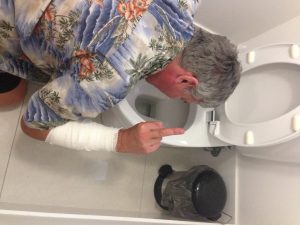I refer to parenting as hypocrisy disease.
And there’s been more than a few times when Amy has said to me, practice what you preach.
 Like barfing and going to work.
Like barfing and going to work.
People should not work when they are sick.
But in the world of food, people are going to lose their jobs if they don’t show up.
Hsuan et al. write in the American Journal of Preventative Medicine that:
Previous studies suggest an association between paid sick leave (PSL) and better population health, including fewer infectious and nosocomial gastrointestinal disease outbreaks. Yet few studies examine whether laws requiring employers to offer PSL demonstrate a similar association. This mixed-methods study examined whether laws requiring employers to provide PSL are associated with decreased foodborne illness rates, particularly laws that are more supportive of employees taking leave.
Methods:
The four earliest PSL laws were classified by whether they were more or less supportive of employees taking leave. Jurisdictions with PSL were matched to comparison jurisdictions by population size and density. Using difference-in-differences, monthly foodborne illness rates (2000-2014) in implementation and comparison jurisdictions before and after the laws were effective were compared, stratifying by how supportive the laws were of employees taking leave, and then by disease. The empirical analysis was conducted from 2015-2017.
Results:
Foodborne illness rates declined after implementation of the PSL law in jurisdictions with laws more supportive of employees taking leave, but increased in jurisdictions with laws that are less supportive. In adjusted analyses, PSL laws that were more supportive of employees taking sick leave were associated with an adjusted 22% decrease in foodborne illness rates (p=0.005). These results are driven by campylobacteriosis.
Conclusions:
Although the results suggest an association between more supportive PSL laws and decreased foodborne illness rates, they should be interpreted cautiously because the trend is driven by campylobacteriosis, which has low person-to-person transmission.
Association of paid sick leave laws with foodborne illness rates
Am J Prev Med. 2017 Sep 1. pii: S0749-3797(17)30359-8. doi: 10.1016/j.amepre.2017.06.029. [Epub ahead of print]
Hsuan C, Ryan-Ibarra S, DeBurgh K, Jacobson DM











